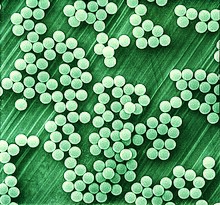
Microbeads, also called Ugelstad particles[1][2][3] after the Norwegian chemist, professor John Ugelstad, who invented them in 1977 and patented the method in 1978,[4] are uniform polymer particles, typically 0.5 to 500 microns in diameter. Bio-reactive molecules can be absorbed or coupled to their surface, and used to separate biological materials such as cells, proteins, or nucleic acids.
Microbeads have been used for isolation and handling of specific material or molecules, as well as for analyzing sensitive molecules, or those that are in low abundance, e.g. in miniaturized and automated settings.
- ^ EP 2424901, Modahl, Grete Irene; Fonnum, Geir & Molteberg, Astrid et al., "Monodisperse submicron polymer particles", published 2017-05-31, assigned to Life Technologies A/S
- ^ Herk, A.M. van, ed. (2005). Chemistry and Technology of Emulsion Polymerisation. Blackwell Publishing. p. 23. ISBN 9781405121132.
- ^ Andersen, Otto; Andrae, Anders S.G.; Walnum, Hans Jakob (2010). "Life Cycle Assesment [sic] of Electronics. Ugelstad-particles Ball Grid Array and Chip Scale Packaging". ResearchGate.
- ^ Rangnes 1997:4–5